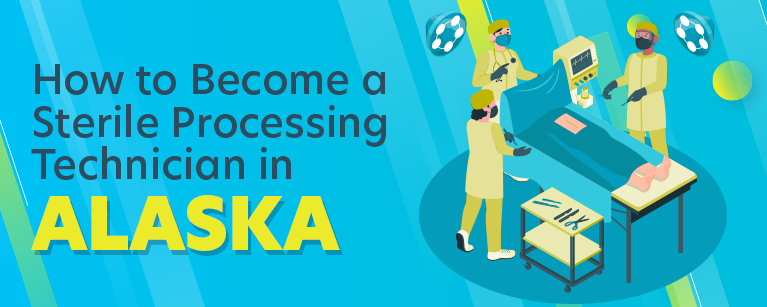
Want to work at a hospital, but don’t want to worry about going to med school?
You could begin a career as a Sterile Processing Technician!
These hospital professionals make sure all the tools surgeons need are clean and ready to go before the procedure has even begun.
In this article, we’ll cover how to become an SPT in the state of Alaska: what schooling and certifications you’ll need, and how to get them!
Table of Contents
How to Become an SPT
The state of Alaska requires no higher education to become a Sterile Processing Technician.
As long as you’ve graduated high school or obtained your GED, you can start submitting applications — but there is one pretty big caveat to taking this path forward.
If you have no formal training or education in Sterile Processing, hospitals, and clinics are much less likely to hire you; they’ll likely pass you up in favor of candidates with more experience.
Luckily, you have two options if you’d like to get certified as an SPT in the state of Alaska: certification via the HSPA or the NBSTSA.
The Healthcare Sterile Processing Association (HSPA)
The HSPA used to be called the International Association of Healthcare Central Service Material Management, or the IAHCSMM.
Despite their name change, they’ve still been a source of SP certification since 1971.
The HSPA has five levels of certification, four of which are for SPTs:
- Certified Registered Central Service Technician (CRCST) – the base-level certification for SPTs
- Certified Endoscope Reprocessor (CER) – an endoscope-specific certification
- Certified Instrument Specialist (CIS) – an advanced instrument certification
- Certified Healthcare Leader (CHL) – a certification for SPT management
Once you fill out your application and get accepted, you can sign up to take the test itself.
There are online courses available on their website to help you prepare, and you’ll also be provided with the HSPA’s Certification Handbook, a content outline, and reference materials.
Certification through the HSPA lasts for a year, after which you’ll have to renew by sending in evidence of continuing education credits and a $50 fee.
The National Board of Surgical Technology and Surgical Assisting (NBSTSA)
Much like the HSPA, you must first submit an application to the NBSTSA before you can take any certification tests.
However, there’s one major difference between the two organizations: to qualify to test for certification at the NBSTSA, you must have graduated from either a Commission on Accreditation of Allied Health Education Programs (CAAHEP) or Accrediting Bureau of Health Education Schools (ABHES) accredited Surgical Technology Program or Military Training Program in Surgical Technology.
You can test with the NBSTSA a maximum of three times per year, though there’s no waiting period to retest in between, and it costs $190 for members and $290 for non-members to test.
Sterile Processing Schools in Alaska
If you’re ready to embark upon your career as a Sterile Processing Technician, you have a few options in Alaska for schooling on the subject.
University of Alaska Anchorage
University of Alaska Anchorage offers a Surgical Technology program that covers everything from operating room procedures to managing medical equipment.
It’s the perfect catch-all program for anyone who’s interested in hospital technician positions, especially since it covers case management, wound care and closure, and patient care in addition to sterilization techniques — but it’s perfect for aspiring SPTs, too!
According to their website, 100% percent of their graduating students find jobs after leaving the university, and the program is accredited by the Commission on Accreditation of Allied Health Education Programs.
The program is highly competitive, however, only admits a total of 15 existing UAA students each year, and students must have all the prerequisite courses completed and a GPA of at least 2.5 before applying.
You must also be fully vaccinated and submit two recommendations and an essay to be accepted to the program.
Once you’re actually accepted to the program, you must also complete an externship where you serve as “First Scrub” for at least 120 cases in order to graduate!
Alaska Workforce Investment Board
Alternatively, if that sounds a little too competitive for your tastes, you can participate in an apprenticeship offered by the Alaska Department of Labor and Workforce Development.
Alaskan apprenticeships allow those wishing to change their vocation the chance to learn on the job while actively earning money, meaning you won’t have to put everything on hold to learn a new trade.
The Alaska Job Center Network can direct you toward a registered apprenticeship program for Sterile Processing.
| School Name | Address |
|---|---|
| University of Alaska Anchorage | 3211 Providence Drive Anchorage, AK 99508 United States |
| Alaska Workforce Investment Board | 3301 Eagle St, Ste 305 Anchorage, AK 99503 |
Salary
If you’re worried about what you might make as a Sterile Processing Technician, we’ve got you covered there, too.
It turns out that the average Alaskan SPT makes about $49,213, but salaries can go upwards of $54,000 a year!
Here’s what you can make in some of Alaska’s biggest cities.
Annual Salary Range:| Location | Avg. Annual Salary |
|---|---|
| Anchorage | $50,170 |
| Juneau | $49,723 |
| Fairbanks | $49,962 |
| Sitka | $49,046 |
| Ketchikan | $49,046 |
| Kenai | $49,493 |
| Kodiak | $49,493 |
| Bethel | $49,493 |
| Wasilla | $49,493 |
| Barrow | $49,285 |
Regional Salary in Alaska
| Region | Employed | Avg. Annual Salary | Avg. Hourly Pay | Top 10% Annual Salary | Bottom 10% Annual Salary |
|---|---|---|---|---|---|
| Anchorage, AK | 90 | $58,020 | $27.89 | $75,510 | $43,440 |
* Employment conditions in your area may vary.
Frequently Asked Questions
Do I need an Associates/Bachelor's Degree to become a Sterile Processing Technician in Alaska?
No, you don’t need a degree; however, certification or on-the-job experience will help you in the long run.
What's the best way to get on-the-job experience for Sterile Processing in Alaska?
Alaska offers registered apprenticeship programs that will allow you to earn money while you gain important skills for Sterile Processing.
Can I go to school for Sterile Processing in Alaska?
Yes, the University of Alaska Anchorage offers a major on Surgical Technology.
However, the program is highly competitive, only admitting 15 existing UAA students per year.
Sterile Processing Technician Info by State
- Alabama
- Alaska
- Arizona
- Arkansas
- California
- Colorado
- Connecticut
- Delaware
- Florida
- Georgia
- Hawaii
- Idaho
- Illinois
- Indiana
- Iowa
- Kansas
- Kentucky
- Louisiana
- Maine
- Maryland
- Massachusetts
- Michigan
- Minnesota
- Mississippi
- Missouri
- Montana
- Nebraska
- Nevada
- New Hampshire
- New Jersey
- New Mexico
- New York
- North Carolina
- North Dakota
- Ohio
- Oklahoma
- Oregon
- Pennsylvania
- Rhode Island
- South Carolina
- South Dakota
- Tennessee
- Texas
- Utah
- Vermont
- Virginia
- Washington
- West Virginia
- Wisconsin
- Wyoming









